Her Deg ar Hen Dir - An Honest Challenge
The Marquis of Anglesey was pleased to announce that "on the 13th August 1913 a match would take place between Mr James Braid (winner of the open championship five times) and Mr J H Taylor (the current open champion, also five times winner) on the latest Herbert Fowler designed course".
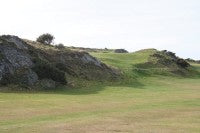 This gem of a course is Bull Bay Golf Club on the Isle of Anglesey - the sticky-out bit of north west Wales. Here, Herbert Fowler created a course that is every bit a match for his top designs (including Walton Heath, Beau Dessert and Delamere Forest) without lifting or laying a blade of grass.
This gem of a course is Bull Bay Golf Club on the Isle of Anglesey - the sticky-out bit of north west Wales. Here, Herbert Fowler created a course that is every bit a match for his top designs (including Walton Heath, Beau Dessert and Delamere Forest) without lifting or laying a blade of grass.
Using the natural features of the land, he mapped out a course that climbs and falls, twists and turns, through valleys, across plateaus, between rocky outcrops and areas of gorse.
Overlooking the Irish Sea, it is the most northerly course in Wales with panoramic views of the mountains of Snowdonia, the Isle of Man and the Cumbrian Hills.
The course measure 6276 yards par 70, course is not long by modern standards but, defended by its natural hazards and the ever-changing wind direction, offers a challenge to golfers.
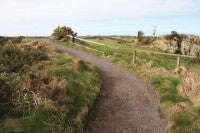 The club motto is "Her Deg ar Hen Dir" meaning an "honest challenge on ancient land".
The club motto is "Her Deg ar Hen Dir" meaning an "honest challenge on ancient land".
With a population of just under 70,000 and a total area of only 275 square miles it is, perhaps, surprising that Anglesey supports seven golf courses. However, with its heritage coastline and ferry terminal to Ireland it does attract visitors all year round.
The course is unusual in that it has changed very little since its inception, with the natural topography resisting any urge to lengthen it. There are enough natural hazards, along with a smattering of small bunkers, to catch out any wayward golfer.
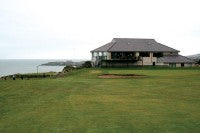 It is classed as a heathland, cliff top course with a heavy, yet shallow, soil, lying over granite rock with a fine turf top. There are areas of the course where the granite breaks through the surface, adding to the spectacular look and also ready to assist a wayward golf ball further seaward!
It is classed as a heathland, cliff top course with a heavy, yet shallow, soil, lying over granite rock with a fine turf top. There are areas of the course where the granite breaks through the surface, adding to the spectacular look and also ready to assist a wayward golf ball further seaward!
The Head Greenkeeper is Andy Peel, who came to the club in 1994 having previously worked at the Ellesmere Golf Club for four years and, before that, the William Wroe Golf Course, a municipal course on the Mersey flood plane.
David Golding, now of the GTC, was Course Manager when Andy worked at William Wroe. Andy also spent three years at Reaseheath College under the tutorage of Dennis Motram who he describes as "a great guy, so enthusiastic and told it how it is - that greenkeeping is a simple job."
Andy has carried on Dennis's theme of keeping it simple, and classes himself has a traditional greenkeeper aiming to maintain the course with low inputs and promoting natural surfaces.
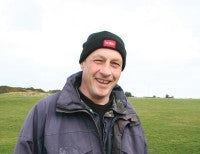 He knew, when he joined Bull Bay, that his staffing and machinery budgets would be minimal, and says one of the main reasons he took on the job was for the challenge that scenario offered.
He knew, when he joined Bull Bay, that his staffing and machinery budgets would be minimal, and says one of the main reasons he took on the job was for the challenge that scenario offered.
With just two staff under him Andy has to be a hands-on greenkeeper. Maintaining the course has to be his main priority; "Office work can wait for the bad weather or the long nights" he says.
His two assistants are James Radcliffe, a local lad with thirty years service, and Bill Ashurst, twenty-five years. Both enjoy their idyllic, island lifestyle, and both have embraced Andy's work ethic.
"One of the reasons so much is achieved is the fact that we are a very experienced team and work well together" says Andy. "Over the years each of us has developed his own work ethic. They are a very easy pair to manage as they instinctively know what is required."
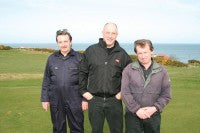 Bill is over retirement age but stays on because he enjoys his work so much. "Who knows what I'll do when he eventually decides to retire?" remarks Andy.
Bill is over retirement age but stays on because he enjoys his work so much. "Who knows what I'll do when he eventually decides to retire?" remarks Andy.
"Being such a small team we have to prioritise what we do," says Andy. "If something is left over from the previous week it will be our number one priority on Monday morning. "
"Our maintenance budget is limited, so we just get on and do what we can. The club has, at present, just over 400 members (having peaked at 600) so that situation is unlikely to change.
In the summer months the greenkeeping staff work a forty hour week, starting at 7.00am and finishing at 3.30pm. "In the winter we work thirty-five ours a week, averaging out at thirty-seven and a half hours a week over the year. Even though we have official working hours it is not unusual, but rare, to find one or all of us here outside these times just to get a job completed" says Andy.
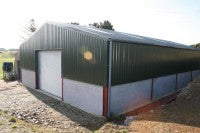 "We prioritise the work pretty much as you might expect - greens and approaches, tees, fairways and bunkers, in that order. Fortunately, because the natural topography dictates what grass is left to be mown, the course lends itself to being managed simply.
"We prioritise the work pretty much as you might expect - greens and approaches, tees, fairways and bunkers, in that order. Fortunately, because the natural topography dictates what grass is left to be mown, the course lends itself to being managed simply.
And even our members understand the situation and do a pretty good job of raking the bunkers! There are only twenty-eight on the course and they are all very small and unobtrusive. They only get raked by us perhaps two or three times a week, they are much more like a natural hazard and not some major feat of engineering."
"Our machinery plays a very important part in our efficiency" says Andy. "In 2006 we purchased three Toro mowers. We chose Toro because not only do we feel they are the best machines but also, with resources limited, we also had to budget for machinery lasting longer than our targeted five year replacement date. Our Toro dealer is over two hours drive away but provide a service as though local. With three staff the use of hand mowers does not enter the equation. With the exception of regrinding, all machinery maintenance is carried out 'in-house'.
"We had an old three-gang cylinder-mower for semi-rough areas, we replaced this with a Lastec Articulator rotary gang which has also saved valuable time, from four and a half days down to just over three."
"Because of the layout of the land, the majority of our tees are small, ranging from less than 100 square metres on some holes, this includes competition, general play and ladies, to ones which we have rebuilt that are 400 square metres in size." Having said that, Andy is keen to increase the size of the tees, where space allows, to ease the wear pattern but, again, available time and budget will dictate when this work will be undertaken.
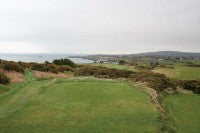 "I first saw the course when holidaying here in the seventies" says Andy, "and always thought what a great place it would be to work. When I first arrived the course was in pretty good condition but needed, in my opinion, a few tweaks, but nothing too serious."
"I first saw the course when holidaying here in the seventies" says Andy, "and always thought what a great place it would be to work. When I first arrived the course was in pretty good condition but needed, in my opinion, a few tweaks, but nothing too serious."
"For example, the fairways were straight, like runways, there was too much poa in the greens with a small layer of thatch (that my predecessor had started to reduce) and, as previously mentioned, small tees. The easiest to resolve were the fairways. By simply mowing we shaped them through and around the natural humps and hollows and the course immediately took on a more aesthetic look."
"The greens were more of a challenge. We slowly reduced fertiliser inputs and, even though in 1997 we had installed a pop-up irrigation system (for greater control, not greater volume), reduced water usage. Within three years there were signs that the finer fescues were coming back to our 82 year old greens."
"By 2000 our management programme was running the poa ragged, but all was not rosy. The fescue was not filling in quickly enough. It was at this point Alistair Beggs of the STRI was called in to support me, and to reassure the members that the work we were doing was in the best interests of the course.
An overseeding programme was initiated, comprising of straight bent in the August of that year and a mixture of 50% chewings and 50% slender fescues in the autumn and, by 2002, we had dropped the bents in favour of the excellent results we were seeing with the fescues. The greens now have around a 60% fescue sward with the other 40% made up of bents, Yorkshire fog, bits of rye and some poa."
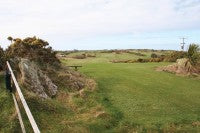
"We've got our problems as well" says Andy. "There were some areas of protruding granite on the 1st green which had just risen to the surface over many years. In 1989 a rebuild was undertaken in-house and was, unfortunately, not too successful. Apparently, they found they were sixty tonnes short of soil, so they laid a carpet of pure sand just below the turf.
The results of this work can still be seen today with a distinct difference in colour and performance on that part of the green. It tends to dry out more quickly, even though remedial work was carried out over the following years using a 70/30 topdressing."
"Our weekly regime is pretty standard, although we do alternate days when other tasks are pressing. For example, greens are mown four to five times a week during the growing season" (height of cut three old pennies as Andy likes to say - or 5mm in new money) using the Toro Triple 3250D greens mower. Winter height is 6mm (four old pennies). Holes are changed once or twice a week."
"We cut the tees twice a week using our Toro 2000 tees mower - 10mm in the summer and 12mm in the winter. We use a Toro 6500 to cut the fairways twice a week, maintaining a height of between 15-16mm. The articulator keeps the semi-rough to 50mm on a weekly basis."
"The main aeration work is carried out through the autumn and early winter. We 'vertidrain' the greens using a Wiedenmann Terra Spike set to a depth of 150mm. That is about the deepest we can go due to the granite below. This work, being carried out during the last week in September. Then, using the sisis 8" deep slitter, aiming for between 6-8 passes before Christmas. This piece of equipment is, in my mind, a very underrated, yet essential, asset to the maintenance upkeep of any fine turf area. 
In early March we pencil tine the greens (8mm) prior to an application of Vitax Ultraflow granular (the windy nature of the course makes this easier to apply and we have personally found we get better results from the granular) followed by a monthly programme of Breaker triple. Feeding is kept to a minimum with only one 20kg bag of lawn sand being applied per green, usually in late March.
However, if I think it is required I will apply a further application of lawn sand around June. The tees are fed with a 8:0:0 npk granular feed in May and occasionally receive another dose later in the year."
"The greens are topdressed three times a year, in April, May and September, applying about one tonne of 70/30 per green."
It is clear that Andy has succeeded with his sustainable practices. He and his two assistants are at one with the ecology and geology of the course. "It's not rocket science, is it?" says Andy. "As my old college tutor used to say, 'keep it simple', and that's what we do here. It's all about understanding the needs of the grass plant and managing the surfaces accordingly. I firmly believe that golf should be played on natural surfaces - poa annua is not a natural grass! A golf course should 'fit' its environment."
With just two staff, the course is a credit to Andy and his 'team'. Even in February the greens were firm and true, the course looked magnificent and was immaculately presented.
The results of the past sixteen years have seen the greens playable 365 days of the year. There have been no temporaries since 1998. "It makes me smile when some golf courses mow out winter greens - they choose a nice patch of fescue to rest the poa!"
What's in the shed?
The club is currently building a brand new garage and wash down facility that will not only store machinery but also provide mess room facilities for the staff.
Toro 3250D greens mower (purchased 2006)
Toro 2000 tees mower (2006)
Toro 6500 fairway mower (2006)
Ford 2120 43hp tractor (1994)
Ford 1920 35hp tractor (1999)
Lastec Articulator (1999)
Richard Long Topdresser (1998)
3 wheel Cushman (1995)
Hardy 300L sprayer (1995)
Wiedennmann 1.2m (1998)
Lewis 38Q loader (2005)
Sisis Vari-seeder (2002)
Ransomes 160D MK I thatchaway (2000)
Sisis 8' brush (1981)
Sisis 8" deep slit (1981)
